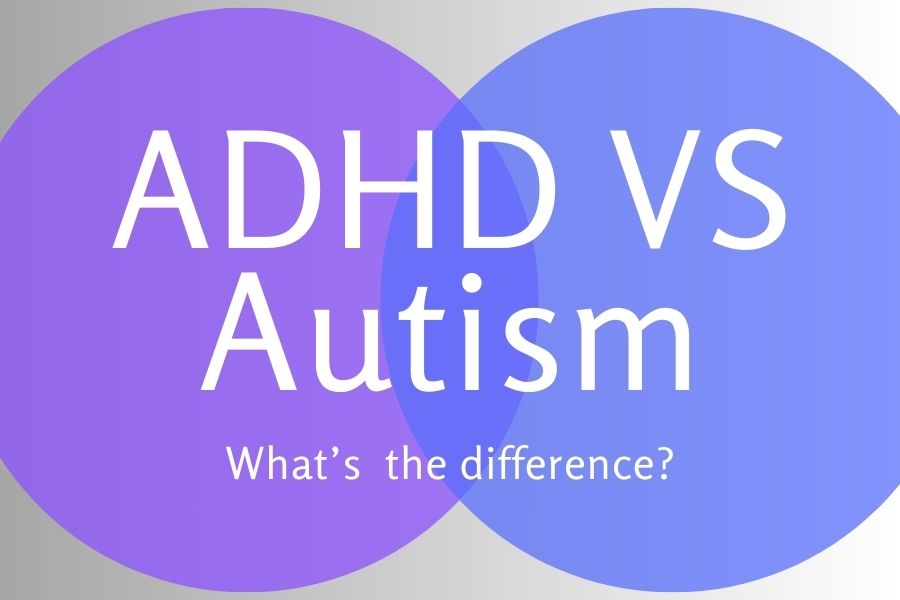Understanding the Overlap Between ADHD and Autism
Exploring the connection between ADHD and Autism can feel overwhelming. For many people, the lines between the two conditions aren’t always clear, especially when symptoms seem to blur together in daily life.
Take executive functioning, for example. Is a messy desk or an overflowing inbox a sign of ADHD, Autism, or both? What about impulsivity, constant restlessness, or the tendency to misplace keys, phones, and other essentials? These everyday challenges don’t always fit neatly into one diagnostic category.
Even those with professional training often find it difficult to separate the two. Personal experiences don’t always align with textbook definitions, which highlights just how complex this overlap can be. Research supports this confusion, showing that ADHD and Autism share many characteristics and can be difficult to distinguish clinically.
Instead of drawing hard lines, it may be more helpful to recognise the shared traits and understand that both conditions can exist together. This perspective acknowledges the “messiness” of real-life experiences while validating the fact that many people with ADHD and Autism navigate both sets of challenges.

Autism and ADHD: Key Similarities and Differences
Autism and ADHD share a significant amount of overlap, yet they are distinct conditions with their own defining features.
Autism is often characterised by challenges in social communication and interaction, along with a preference for structure, repetition, and routine. This can include behaviours such as engaging in special interests, stimming, or relying on specific rituals for self-regulation.
ADHD, on the other hand, is marked by difficulties in maintaining attention and regulating activity levels. Hyperactivity, impulsivity, and distractibility are common traits, which can affect daily functioning in school, work, and relationships.
Both conditions are relatively common in the population. Autism is currently recognised as one of the fastest-growing developmental conditions, affecting an estimated 2.8% of children aged 3–17. ADHD is even more widespread, with prevalence estimates ranging between 5–11%.
The Genetic Link Between ADHD and Autism
Our understanding of the overlap between ADHD and Autism is still relatively new. For many years, diagnostic systems treated the two conditions as mutually exclusive. Before the release of the DSM-5 in 2013, if someone was diagnosed with Autism (or Asperger’s, as it was then called), they could not also receive a diagnosis of ADHD. Clinicians were forced to choose the “best fit” label, even if both sets of traits were clearly present. Thankfully, this has since changed, and it’s now recognised that a person can meet criteria for both conditions.
Research continues to shed light on just how intertwined these two conditions are. Studies suggest that anywhere from 22–83% of autistic children could also qualify for an ADHD diagnosis, while around 30–65% of children with ADHD show significant autistic traits. Twin and family studies further highlight the genetic connection, suggesting a 50–72% genetic overlap between the two.
This doesn’t mean that everyone will meet the full diagnostic criteria for both. Some people with Autism may display ADHD-like traits without qualifying for a formal diagnosis, and the reverse is also true. This “blending” of traits suggests that so-called “pure” ADHD or “pure” Autism might be less common than we once thought.
Shared Genetics Between ADHD and Autism
One of the leading explanations for why ADHD and Autism so often occur together is that they share a common genetic basis. Research by Leitner et al. (2014) and others supports this idea, pointing to strong evidence from twin studies. These studies suggest a 50–72% genetic overlap, indicating that inherited factors may play a major role in why the two conditions frequently appear within the same individuals and families.
Beyond genetics, research also highlights a significant neurobiological overlap. In other words, the brains of people with ADHD and Autism show similarities in how they function. For example, Sokolova et al. (2017) suggest that challenges with attentional control, difficulties with inattention, and reduced flexibility in task-switching could reflect shared biological pathways that link the two conditions.
Together, these findings suggest that the overlap between ADHD and Autism is not coincidental—it is deeply rooted in both genetics and brain biology.
Where ADHD and Autism Traits Overlap
ADHD and Autism are both neurodevelopmental conditions that affect how the brain processes information, responds to sensory input, and manages executive functioning. While they are distinct, they also share many traits that can sometimes make it hard to tell them apart. Below are some of the key areas where ADHD and Autism commonly overlap.
Nervous System Sensitivity
People with ADHD and Autism often have highly sensitive nervous systems. This makes it easier to become overwhelmed or stressed and may increase the risk of certain health challenges. Self-care strategies that calm and stabilise the nervous system are especially important.
Special Interests and Hyperfocus
Deep focus on passions or interests shows up in both conditions.
- Autism: This often appears as monotropism, or a strong, sustained focus on a limited range of interests.
- ADHD: This is usually linked to an interest-based nervous system, where attention intensifies around novelty, urgency, or areas of passion.
In both cases, hyperfocus can feel like being pulled into “the vortex,” where attention is fully absorbed.
Sensory Processing
Differences in sensory processing are common in both ADHD and Autism. A person may be highly sensitive to sounds, lights, or textures—or may actively seek out strong sensory input. These sensitivities can vary across senses and can even shift depending on the situation.
Social Interaction
Both ADHD and Autism can make social situations challenging, though often for different reasons.
- For ADHD: Social struggles often come from inattention and impulsivity. For example, missing cues when someone is disinterested, or blurting out thoughts mid-conversation.
- For Autism: Social challenges are more connected to differences in reading nonverbal cues, body language, switching between topics, and interpreting social “rules.”
Despite these differences, both groups often connect in their own unique ways, such as diving into deep discussions about shared interests or skipping small talk.
Stimming and Fidgeting
Repetitive movements, such as stimming or fidgeting, are used to self-regulate in both groups. Stimming (more common in Autism) helps manage sensory input, while fidgeting (common in ADHD) often releases excess energy. The behaviours can look similar, but their functions may differ slightly.

Emotional Regulation
Both ADHD and Autism are associated with intense emotional experiences and difficulty regulating them. This can stem from sensory sensitivities, brain differences (such as heightened amygdala activity), interoceptive challenges, and nervous system rigidity.
Executive Functioning
Executive functioning challenges are central to ADHD and also common in Autism. These difficulties may include problems with organisation, working memory, decision-making, regulating attention, shifting focus, and remembering objects or tasks (sometimes called “object permanence”).
Time Perception
Linked to interoception is the concept of time perception. Many ADHDers and Autistic people experience “time blindness” or “time agnosia,” making it difficult to judge how much time has passed or how long tasks will take.
Interoception (Internal Awareness)
Interoception—sometimes called the “eighth sense”—is our ability to notice internal signals like hunger, thirst, or emotions. Many people with ADHD or Autism experience less accurate interoceptive awareness. This can make it harder to notice needs until they feel urgent, which in turn affects self-care and emotional regulation.
Rejection Sensitivity
Rejection-sensitive dysphoria (RSD), a term often used in ADHD research, refers to extreme emotional pain around rejection or criticism. While RSD is most often associated with ADHD, many Autistic people also experience heightened rejection sensitivity, often shaped by negative feedback, social challenges, and nervous system sensitivity.
✨ While ADHD and Autism each have distinct features, the overlap between them is significant. Understanding these shared traits can help make sense of lived experiences and reduce the pressure to neatly separate one set of challenges from the other.
Shared Risks and Challenges for ADHD and Autism
Alongside overlapping traits and neurological similarities, people with ADHD and Autism also face many of the same psycho-social risks. These challenges can impact wellbeing, relationships, and quality of life. Below are some of the areas where these risks show up most strongly.
Self-Harm and Suicide Risk
Self-harm and suicidality are significantly higher among both ADHDers and Autistic individuals. For some, these behaviours may be linked to regulating overwhelming emotions or sensory overload.
- Among girls with ADHD, self-harm rates are particularly concerning, especially for those with combined-type ADHD. Studies show rates as high as 69% in adolescents with ADHD, compared to 32% in non-ADHD peers.
- Autistic individuals, especially girls and gender-diverse people, also report high rates of self-harm.
- Research shows that both ADHDers and Autistic people are several times more likely to experience suicidal ideation and attempts than neurotypicals, with women and those with co-occurring depression or anxiety at even higher risk.
Victimisation and Exploitation
Both groups experience disproportionately high rates of peer victimisation and, in some cases, violent victimisation.
- ADHD: Hyperactivity and impulsivity traits are associated with a greater risk of being bullied. Girls with ADHD are especially vulnerable.
- Autism: Autistic women and genderqueer individuals report much higher rates of sexual assault and exploitation. Traits such as being overly trusting, missing social manipulation cues, or taking language literally may increase this risk.
Addiction and Substance Use
Addiction is a common challenge for both ADHDers and Autistic people.
- ADHD: Research shows ADHD is strongly linked with substance use disorders, including alcoholism. Adults with ADHD are estimated to be 5–10 times more likely to struggle with alcoholism than neurotypicals. Roughly 25% of adults in treatment for substance abuse also have ADHD.
- Autism: While once thought to be less affected, recent studies show Autistic individuals without intellectual disability are twice as likely to develop addictions compared to neurotypicals. Substance use may serve as a way to cope with social stress or sensory overwhelm. Impulse-driven addictions such as gambling, shopping, and gaming are also more common.
Eating Disorders
Disordered eating is another shared risk.
- ADHD: Both anorexia and bulimia are more common, with rates significantly higher among girls with ADHD compared to non-ADHD peers.
- Autism: Research suggests around 23% of people with anorexia may also be Autistic, though this number is likely underestimated due to underdiagnosis in women. Avoidant/Restrictive Food Intake Disorder (ARFID) is also more prevalent in both groups.
Mood Disorders and Other Mental Health Conditions
Co-occurring psychiatric conditions are the norm rather than the exception for both ADHDers and Autistic individuals.
- Mood disorders: Depression and anxiety frequently occur in both populations. In ADHD, depression co-occurs in 9–50% of cases, and women appear particularly affected. Bipolar disorder is also more common in both groups.
- OCD: Obsessive-Compulsive Disorder overlaps significantly with both ADHD and Autism. Around 30% of people with ADHD also have OCD, and familial studies show strong links between OCD and Autism.
- General prevalence: Studies suggest that up to 79% of Autistic individuals meet criteria for at least one psychiatric condition, while children with ADHD make up about half of psychiatric referrals.
✨ The challenges faced by ADHDers and Autistic people are not only neurological but also deeply shaped by their social environments. Recognising these shared risks is essential for providing better support, reducing stigma, and creating safer spaces for neurodivergent individuals.
Overlapping Social Identities in ADHD and Autism
Beyond neurological traits, ADHDers and Autistic individuals often share social identities and experiences that set them apart from neurotypical populations. Research shows that both groups are more likely to identify with diverse gender and sexual identities, while also navigating life as neurominorities in systems not built for them.
Gender Identity and Neurodivergence
Gender diversity is significantly higher among ADHDers and Autistic people compared to the general population.
- Studies suggest trans people are 3–6 times more likely to be Autistic (Warrier et al., 2020).
- Genderqueerness is also more common, with research showing it to be 7.6 times more prevalent among Autistics and 6.6 times more prevalent among ADHDers compared to neurotypicals (Strang et al., 2014).
- Conversely, gender-diverse individuals are more likely to have ADHD or Autism compared to cisgender peers.
Sexual Orientation and Neurodivergence
ADHD and Autism are also linked with greater sexual diversity.
- Autistic individuals are 2–3 times more likely to identify as lesbian, gay, or bisexual compared to the general population. Autistic men more often identify as heterosexual, while Autistic women more frequently identify as non-heterosexual (Dewinter et al., 2017; George & Stokes, 2018).
- People with ADHD are also more likely to identify as non-heterosexual compared to non-ADHD peers (Barkley et al., 2008).
Living as Neurominorities
ADHDers and Autistic people often experience life as neurominorities—a term that reflects how their brains differ from the majority. Schools, workplaces, and healthcare systems are largely designed with neurotypical needs in mind, which can create significant barriers to access and success.
When combined with other identities, such as gender or sexual diversity, these challenges are often magnified. The result can be chronic stress, a greater risk of marginalisation, and the need to constantly adapt in environments that do not naturally accommodate neurodivergent ways of being.
Autism vs. ADHD: Telling Them Apart
Because Autism and ADHD share so many traits—and can often occur together—it isn’t always easy to tell where one ends and the other begins. Distinguishing between the two requires looking closely at the underlying mechanisms behind behaviours, rather than just the behaviours themselves.
Social Interaction Challenges
Both ADHD and Autism involve social difficulties, but the reasons behind them are usually different.
- ADHD: Social struggles are often the result of impulsivity and inattention. For example, someone with ADHD might miss cues because they were distracted, not because they didn’t understand them. When focused, many ADHDers are fully capable of reading social signals.
- Autism: Social challenges are more deeply rooted in difficulty intuitively interpreting neurotypical cues, such as body language or tone of voice. Autistic people often rely on logic and learned strategies to navigate social situations rather than instinctive understanding.
Key Considerations for Assessment
When trying to differentiate between the two, it can help to ask:
- Is the difficulty with socialising due to inattention and impulsivity, or does it come from relying on learned/analytical strategies to interpret cues?
- Does the person appear to mask or camouflage their differences in social situations (something particularly common among Autistic individuals)?
Tools like the Camouflaging Autistic Traits Questionnaire (CAT-Q) can sometimes be useful for exploring these questions.
Social Motivation
Another distinction lies in motivation. On average, people with ADHD tend to show higher levels of social drive, actively seeking out interactions and connection. Autistic individuals may have less spontaneous motivation for social engagement, though this varies widely between people.
Spotting the Differences: Routine Changes and Movement Patterns
While ADHD and Autism often share overlapping traits—like sensory sensitivities, focused interests, and restless movements—key differences emerge when you look at how someone handles change and the purpose behind their behaviors.
Adapting to Change
One of the clearest distinctions lies in how individuals respond to disruptions in routine:
- Autism: Unexpected or externally imposed changes often trigger strong emotional responses such as anxiety, irritability, or distress. Predictability provides a sense of safety, and disruptions can feel overwhelming.
- ADHD: Change itself is not usually the central issue. In fact, ADHDers may seek novelty and create their own shifts in routine. Their challenges tend to come from following through with consistency, not resisting external change.
A useful approach is to consider whether the change is self-initiated or externally imposed. Autistic individuals typically cope better with changes they decide themselves, while ADHDers often adapt more flexibly when others introduce changes.

Repetitive Movements vs. Hyperactivity
Behaviors like pacing, tapping, or rocking may look alike on the surface, but the intention and internal experience differ:
- Repetitive Behaviors (Autism):
- Function: Provide comfort, regulate sensory input, or relieve anxiety.
- Examples: Rocking, flapping, spinning, repeating phrases.
- Pattern: Consistent, ritualistic, and often triggered by stress or overstimulation.
- Hyperactivity (ADHD):
- Function: Outlet for excess energy or restlessness, driven by an overactive nervous system.
- Examples: Fidgeting, tapping, running around, interrupting.
- Pattern: Sporadic, less predictable, and not tied to specific triggers.
Key Questions to Guide Assessment
- Purpose: Is the behavior soothing and regulating (Autism), or is it an impulsive release of energy (ADHD)?
- Context: Does it occur in response to stress or sensory overload (Autism), or across situations without clear triggers (ADHD)?
- Consistency: Are the behaviors patterned and ritual-like (Autism), or variable and changing (ADHD)?
Practical Interview Tips
When evaluating, ask direct but empathetic questions to understand the person’s inner experience:
- “Does this help you feel calmer or more in control?”
- “Do you do this because you feel restless or full of energy?”
By focusing on why the behavior occurs rather than just what it looks like, you can more accurately distinguish between Autism-related repetitive behaviors and ADHD-related hyperactivity.
Screening for Both ADHD and Autism
When assessing for ADHD or Autism, it’s important to routinely screen for both conditions. Despite their substantial overlap, Autism is often overlooked in ADHD assessments, and ADHD may be missed in Autism evaluations. Incorporating tools for both ensures a comprehensive understanding of an individual’s neurodivergent profile.
Screening Tools for ADHD Assessments
When evaluating ADHD, consider including Autism-focused measures to capture potential co-occurring traits:
- Autism-Spectrum Quotient (AQ) – Measures the degree of autistic traits.
- Ritvo Autism Asperger Diagnostic Scale (RAADS) – Assesses symptoms across multiple domains of Autism.
- Camouflaging Autistic Traits Questionnaire (CAT-Q) – Explores masking and compensatory behaviors in social situations.
These tools help create a fuller picture of the individual, ensuring that Autistic traits are identified even in those primarily seeking an ADHD assessment.
Screening Tools for Autism Assessments
Similarly, when assessing for Autism, including ADHD-specific screeners is essential:
- Adult ADHD Self-Report Scale (ASRS-5) – Screens for attention, hyperactivity, and impulsivity traits.
This dual approach allows clinicians to consider both ADHD and Autism, supporting accurate diagnosis and tailored interventions.
Screening for Both ADHD and Autism
When assessing for ADHD or Autism, it’s important to routinely screen for both conditions. Despite their substantial overlap, Autism is often overlooked in ADHD assessments, and ADHD may be missed in Autism evaluations. Incorporating tools for both ensures a comprehensive understanding of an individual’s neurodivergent profile.
Screening Tools for ADHD Assessments
When evaluating ADHD, consider including Autism-focused measures to capture potential co-occurring traits:
- Autism-Spectrum Quotient (AQ) – Measures the degree of autistic traits.
- Ritvo Autism Asperger Diagnostic Scale (RAADS) – Assesses symptoms across multiple domains of Autism.
- Camouflaging Autistic Traits Questionnaire (CAT-Q) – Explores masking and compensatory behaviors in social situations.
These tools help create a fuller picture of the individual, ensuring that Autistic traits are identified even in those primarily seeking an ADHD assessment.
Screening Tools for Autism Assessments
Similarly, when assessing for Autism, including ADHD-specific screeners is essential:
- Adult ADHD Self-Report Scale (ASRS-5) – Screens for attention, hyperactivity, and impulsivity traits.
This dual approach allows clinicians to consider both ADHD and Autism, supporting accurate diagnosis and tailored interventions.





.svg)

.svg)


